
Red Square: Saint Basil's Cathedral at Night.
Click on any thumbnail to download a larger version of the selected picture. (So it's a big thumb, okay?!?)
From seventh grade through my freshman year in college, I studied Russian and in March of 1976, my eighth grade year, I visited Moscow, Tver, and St. Petersburg (then Leningrad) on a school-arranged tour. We stayed for 8 days and made the rounds of many museums and landmarks. Russia was much different then and I would be very interested in returning to see how things have changed.
We flew into Moscow at the end of a cramped 13 hour flight on a Boeing 737. I had little idea of what to expect as I watched the forests around the airport rise up to meet the plane. The ground was covered with snow that clearly hadn't had much opportunity to thaw since it was liberally spattered with black dirt. Full of the foreboding produced by our American heritage and the stories that had been told of previous school visits, we warily passed through Customs. We were certain to be watched, we had been told, and it was certain that our hotel rooms would be bugged. Students had been deported to Turkey for misbehavior and anti-Soviet sentiment in the past. It could happen again. The first night, we ventured out onto Red Square, location of Lenin's Tomb, crossroad of centuries of history and oppression, deep in the shadow of the Kremlin wall.

Unfortunately, my apprehensions were reinforced that night when men approached me and, in rough English, demanded to buy my jeans. They weren't friendly and they weren't happy and their mood wasn't enhanced by my refusal. Some of the other students were looking to sell their jeans. Jeans brought a high price on the black market at the time and some of them were hoping to make some significant trades (A few eventually did.) but my jeans were my only pair of pants and I wasn't likely to part with them.

Nonetheless, Red Square was beautiful at night and being in a place so remote, so foriegn, and so forbidden was exciting despite its inhospitality. We wandered around the square for a while, watched the changing of the guard at Lenin's Tomb, and then headed back to our hotel for the night.

The next morning, we returned to Red Square to see how different it looked in the daylight. The imposing shadows produced by the bright artificial lights were gone and the square was quiet, peaceful, and nearly vacant. We had time to calmly look around and reflect on the history around us. One thing that struck me was how much smaller most of the monuments were than I had imagined before leaving the United States. They had clearly been built for the smaller people that lived in previous centuries. Saint Basil's was cramped, dingy, and cold on the inside. Those distictive onion domes turned out to be only an architectural artifice. There was only one narrow passage with short worn stairs leading up into the darkness. The relative impoverishment of the Czars and Russian society, in general, was clearly evident. I was still very uncomfortable about being watched but Russia didn't seem to be the threat that everyone imagined back home.

During our stay in Moscow, we visited the circus, saw a folk dancing performance, visited GYM (pronounced "Goom"), the largest department store in the world (except that most of the shelves were empty), and visited what was reputed to be the largest toy store in the world (also bearing empty shelves). Most of our time was scheduled and under the supervision of a state-supplied guide. We also visited the museums and cathedrals contained within the Kremlin. Like many older cities, Moscow used to be contained within the walls of a fortress, the Kremlin. Consequently, the Kremlin contains many of the monuments and cathedrals of Russia's past.
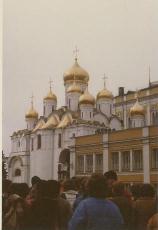
It also holds some examples of the excess and occassional foolishness of the Russian Czars. One example of this is the Czar Pushka (the Czar cannon). The cannon balls manufactured for the Czar Pushka are approximately 3 and a half feet in diameter and no one ever fired it for fear that it would simply explode!


While I was in Russia, I thought that it would be more interesting to take pictures of life on the street rather than taking pictures of the usual museums and monuments. As a result, I ended up taking quite a few pictures out of bus windows and attempting to take candid shots of more day-to-day things that were not the focus of whatever historical hotspot or triumph of Soviet ingenuity we were visiting at the moment. One example is the following picture of foot traffic outside of the Cafe Mars.
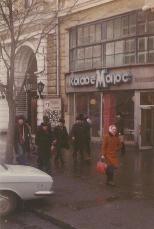
Another example is this candid that I took of a woman sweeping the floors of a subway station.

The particular subway station that we had been taken to was beautiful and immaculate but a few of us had been at other stations the night before and knew that most of the rest bore little resemblance to the sparkling example being presented to us as the norm. The other stations were mundane and functional but antiquated and dirty, as you might expect the subway to be. We had a similar experience at the Soviet Space Museum where over-grandiose claims ran rampant.
I noticed that much of the work we saw being done was performed by women, most of them old, fat women. (Nearly all of the women over the age of 30 seemed to be the short, fat babushkas that people often associate with Russia. Maybe similar observations could be made about certain parts of the United States. Maybe it was youthful exaggeration. I don't know.) This was probably the result of the incredible death toll that World War II had on the men of Russia and was quite a contrast to what I was used to seeing. It fit well with my grandmother's often repeated fears that the communists were going to take over and force her to work in the streets.
Another place we visited in Moscow was the Young Pioneers Palace, where young citizens could learn skills and be made aware of their Soviet heritage. The Young Pioneers was and is the communist youth organization in Russia. It has recently experienced a resurgence under a charismatic young leader and in the general disillusionment with the anti-communist reformers. Our visit consisted of listening to another stream of rhetoric and watching a dance class. The diffuse sunlight was bright enough that the dancing children cast interesting shadows across the floor.
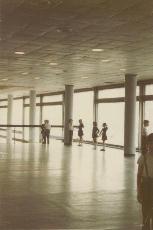
We couldn't visit Moscow without visiting Lenin himself. On one of our days in Moscow, we were ushered to the front of the long line of people waiting to call at Lenin's Tomb and allowed to go in. The door was guarded by two heavily-armed soldiers standing strictly at attention. Only their eyes moved but it was clear that they were checking everyone out very thoroughly. No pictures were allowed. It was hard to believe that we were about to see the man who started it all.
The room was entirely dark, except for a green light illuminating Lenin. He was covered in black material that obscurred all of him except for his hands and head. He was unimaginably small, not much more than 4 feet tall. We passed through fairly quickly, partly spurred on by the resentful looks that had accompanied our cutting in line.
It's amazing to look back and think about how things have changed. If they carried through on their plans to remove Lenin from his tomb and bury him in the Kremlin wall with the other former leaders of the U.S.S.R., then no one else will be able to see his peaceful green face.
After 5 days or so in Moscow, it was time to head for St. Petersburg (then Leningrad). The first leg of our journey, which was from Moscow to Tver, was by bus. It was a long drive over a bleak, snow-covered terrain broken infrequently by small dachas (summer or country homes). Being restless junior high students, we laughed and played poker. I'm sure that the adults keeping track of all of us had their hands full.
Tver is a large industrial city but we stayed outside of town in a motel obviously prepared for foriegn visitors, the Motel Tver. It's name was written in English and Russian across the front of the building and no Russians were staying there. We spent the night and then headed for the train station to resume our journey.
On the way to the station, we stopped at a monument to the unknown soldier on the banks of the large river (which I'll eventually look up) that runs through Tver. While we were there, a couple that had just been married stopped and left flowers at the monument, which is apparently a Russian tradition. It was very cold, though sunny, and there were many groups of people ice fishing on the frozen river.

The train ride passed uneventfully and we arrived in St. Petersburg with 2 days of our trip remaining. For those of you who don't know, the Russian Czar Peter the Great didn't like Moscow and moved the capital to St. Petersburg on the Baltic Sea. There he built a magnificent palace called the Hermitage, which is now a museum housing the greatest cultural treasures from Russia's czarist past. We spent one of our remaining days at the Hermitage. The following picture is a portrait of Peter the Great and his wife which hangs over one of his thrones in the Hermitage.
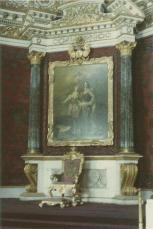
Peter the Great was very unusual for a Russian of his era since he was over 6 feet tall. This apparently made him a very imposing and formitable opponent on the battlefield. There are many interesting and colorful stories about him and his mother, Catherine the Great, both of whom epitomized the excessiveness and outrageousness of the Russian and, more generally, European aristocracy of their time.
The Hermitage houses many cultural treasures from other parts of Europe as well. I believe that the following painting is a Rembrandt. (Please send me email correcting me if I'm wrong or even letting me know if I'm right. It has been so long and I thoughtfully didn't mark any of my pictures so please be nice.)

The following sculpture is a Michelangelo. (Thanks to Dennis Gatt for correcting my previous error.)
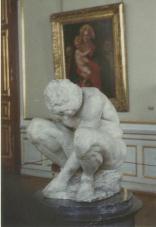
(By the way, I was not using a flash for these photographs. The glare came from sunlight. It happened to be the only sunny day that we had the entire trip.) As before, I was still trying to take pictures of the more mundane parts of the places that we visited so some of my pictures are a little bizarre. This one shows the ornate plaster work on the wall in one of the rooms.

One of the icons of Soviet history also resides in St. Petersburg. The battleship Aurora which the communist revolutionaries used to overthrow the newly-formed democratic goverment is moored not far from the Hermitage.
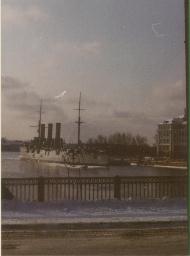
Our final day was mostly filled with preparations for leaving. We had one small hurdle left before returning to the United States. We had to pass through Russian Customs one more time. Many students had traded for various forms of contraband, such as Red Army belts, and were relieved of them on the way to the plane. The rumor was that the belts were sold back to the black marketers who used them on the next group of tourists. Ironically though possibly not coincidentally, those who had dealt most with the black marketeers were hurridly waved through whereas some of the rest of us had our luggage thoroughly searched.
I was glad to be leaving. Although most of what we had been told about surveillence was undoubtedly hype, I felt an air of oppression and barely contained chaos throughout our visit and that had begun to wear on me. I was happy to go home. The popular American image of Russia and the Russians had proved false in its depiction of a fearful technologically advanced menace but seemed true regarding the toll of central control on the human soul.
Mark A. Martin <mark@mark-a-martin.us>
Last modified: Sun Nov 2 11:52:09 PST 2003